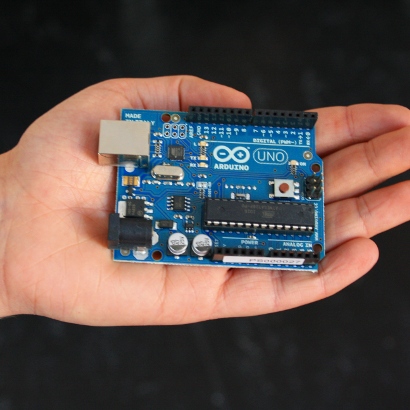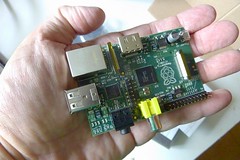 |
| Arduino (from their site) |
| Raspberry Pi (Photo credit: Fotero) |
So we have been playing about a bit with Raspberry Pi and Arduino
Mainly for convenience, but also because they are cool and we are geeks and for example RPi is offering a ARM GNU/Linux box for $25 !
Bottom line - you get an awful lot of processor / interface and convenience at an absurdly low price. If we take that into the context of the building marketplace, though it may be tiny it opens up some very big questions.
We know that very low cost components in tablets and phones are unsettling consumer electronics "norms" - but what will they do in the "real world" of buildings controls (a place where incumbents are defending huge inefficiencies and have very high prices hardware).
In fact if you compare it (the Raspeberry Pi) with something non-reconfigurable with less than 1/000th of the processing power / less than 1/1000,000th of the storage capacity and less I/O functionality across the board you find it is sold by all of the following ..
| motor controller (Photo credit: Mitchclanky2008) |
(A list lifted from Wikipedia, As you can see its a BIG industry so one I have tried to challenge even-handedly)
Alerton Technologies, American Auto-Matrix, AMX, LLC, ASI Controls, Automated Logic Corporation, Beckhoff Automation, ABB Group, BAMI, Carrier Corporation, Celsius Benelux, CGC Solutions & Services, Cisco Systems, Citect, Computrols, Inc., Crestron Electronics, Inc., Delta Controls, Inc., Digital Air Control, Distech Controls, Inc., Dynalite Intelligent Light Pty Ltd, Echelon Corporation, Energy Control Systems, EMT Controls, EnOcean, HomePLC, Honeywell, Iconics, Innotech Control Systems, Invensys Building Systems, ohnson Controls Inc., KMC Controls, LadderWORK, LOYTEC, Novar Controls, Panduit, Priva, Reliable Controls Corporation, SAIA-Burgess Controls, Sauter, Schneider Electric, SCL Elements/CAN2GO, Siemens Building Technologies, Simple Meter (open source), SCI USA, Staefa Control System, StarDraw control, TAC (building automation), TCS Basys Controls USA, Teletrol Systems Inc., Trane Global Control Systems, Trend Control Systems Ltd., WAGO Kontakttechnik GmbH & Co. KG, Wonderware
Mainly (but not all) of the above have outsourced manufacturing and all sell commodity type boxes.
What differentiates these boxes is:
a) price for functionality
b) ( there is no b ) - though some are easier to configure.
So we have a range of products about to flood into markets at far less than 10% of the current price of "named players". The market is HUGE!
So what we can expect is that they all want to differentiate, but most have routes to market (channels) that depend on price sensitive intermediaries.
What we can expect increasingly is that the "box" will become no-name, will comply with open protocols, and the money will be made by those who can figure out how best to install and configure these "boxes" cost effectively and in such a way that energy spend for comfort is minimised.
Why this ? - because it is the sole purpose of these devices! - They aren't fashion accessories. (Ignoring that nonsensical Apple thermostat thing)
At kWIQly.com we believe we have a part to play in this process because there are some "tiny" (in the context of such a mulit-billion industry) niches where we are unquestionably out in front.
Mainly in the field of adding intelligence through pattern recognition. That tiny niche is massive - its the entire added value of controls marketplace - getting them to work better than their counterparts !
But - what does the market think ? - because in the bloodbath that's coming - that will be all that matters.
What do you think ? - let us all know in the comments.




